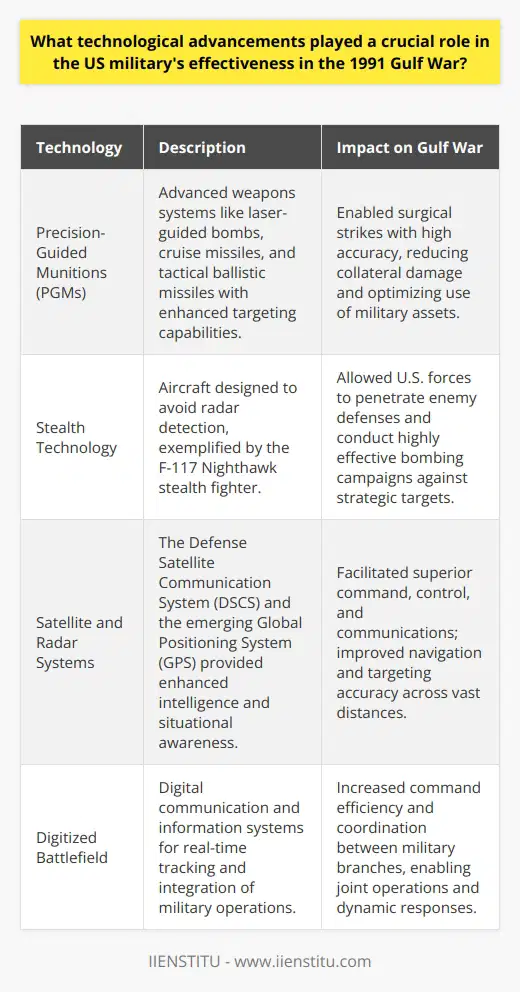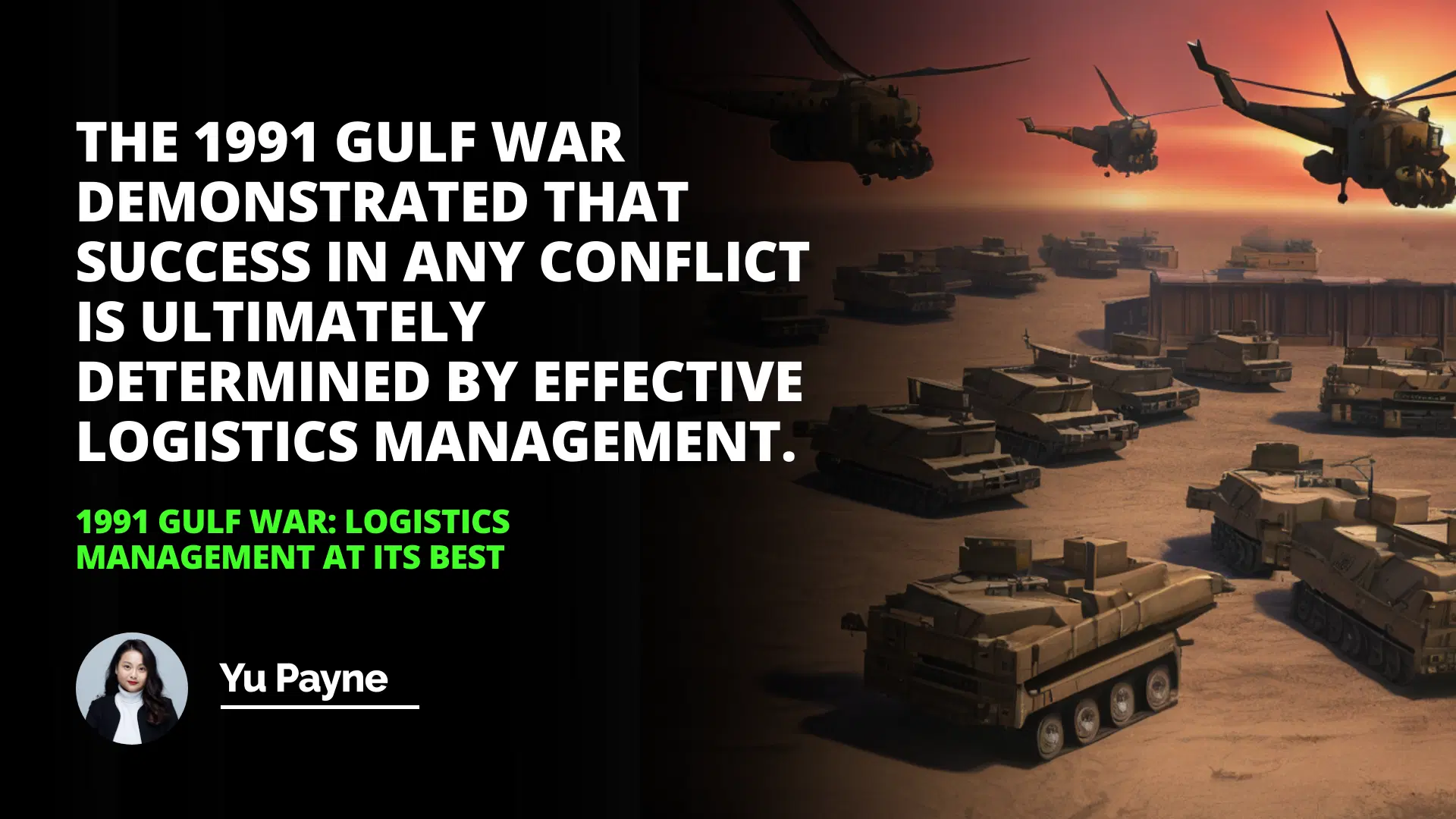
I remember vividly the cold winter night in January 1991 when news broke out about the commencement of the Gulf War. Sitting with my family around the flickering glow of the television, we watched as images of troops mobilizing in the vast deserts of the Middle East filled the screen. It was a tense time, filled with uncertainty, but also with a sense of awe at the sheer scale of the operation unfolding before us. Little did we know then that behind this massive military endeavor was an intricate web of logistics planning that would redefine the way modern warfare was conducted.
Introduction
Logistics Planning
Movement of Troops
Supplies and Resources
Conclusion
The Unsung Heroes of War: The Logistics Teams
The Backbone of Military Success
While generals and soldiers often receive the lion's share of recognition for victories on the battlefield, it's the logistics teams working tirelessly behind the scenes who truly make these achievements possible. The 1991 Gulf War was no exception. The successful deployment and support of over 125,000 ground troops in such a short timeframe was a monumental task that required meticulous planning and flawless execution.
Early Preparations: Months in the Making
The logistics planning for the Gulf War began months before the first troops set foot on Saudi Arabian soil. The challenge was not just moving personnel, but also ensuring that equipment, supplies, and resources were where they needed to be when they needed to be there. This required a level of coordination and communication that was unprecedented at the time.
"Amateurs talk about strategy and tactics. Professionals talk about logistics and sustainability in warfare."
— Robert Hilliard Barrow, USMC General
Implementing the Critical Path Method Project Management Strategy
To manage such a complex operation, the military employed the critical path method project management strategy. This approach allowed them to identify the most crucial tasks and allocate resources efficiently, ensuring that critical deadlines were met without delay.
Identification of Key Tasks: Determining essential activities that could impact the entire operation.
Resource Allocation: Assigning the right people and equipment to the right tasks.
Timeline Optimization: Sequencing activities to avoid bottlenecks.
By focusing on these elements, the logistics teams were able to create a robust plan that could adapt to changing circumstances—a vital capability in the unpredictable landscape of war.
Mobilizing the Masses: Movement of Troops
The Journey Begins
One of my closest friends, Mark, served as a transport officer during the Gulf War. He often recounted the immense responsibility he felt being part of the team that orchestrated the movement of troops across the desert. Over 500 tactical cargo trucks and 200 wheeled vehicles formed convoys that stretched for miles, a steel river flowing through the sands.
Navigating Challenges
Moving such a large force was no small feat and came with its own set of challenges:
1- Harsh Environmental Conditions: The extreme heat during the day and freezing temperatures at night tested both equipment and personnel to their limits.
2- Terrain Navigation: The featureless landscape made it difficult to navigate, increasing the reliance on advanced technology.
The 1991 Gulf War demonstrated that effective logistics management ultimately determines success in any conflict.
3- Security Threats: The constant threat of enemy engagement required heightened vigilance.
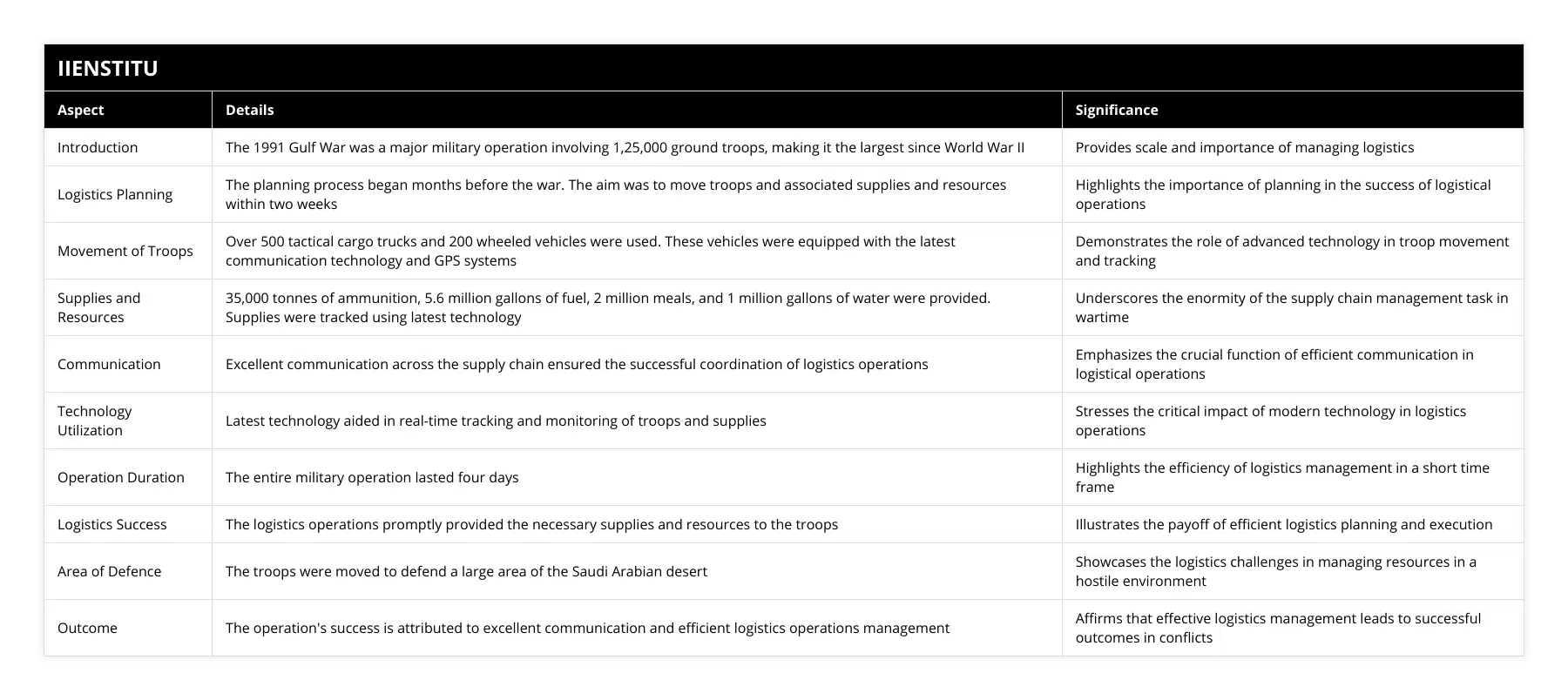
Mark told me, "It was like moving a small city across the desert. Every hour presented a new challenge, but failure was not an option."
Leveraging Technology
To overcome these obstacles, the military utilized cutting-edge technology:
Global Positioning Systems (GPS): For accurate navigation and positioning.
Real-Time Communication Devices: Allowed for instant updates and coordination.
Advanced Tracking Systems: Ensured that all units were accounted for and on schedule.
Sustaining the Force: Supplies and Resources
The Lifeblood of the Military Machine
An army marches on its stomach, but in modern warfare, it also marches on fuel, ammunition, and a myriad of other supplies. The logistics teams were responsible for ensuring a continuous flow of these essential resources.
Staggering Quantities
Consider the sheer volume of supplies required:
35,000 tonnes of ammunition
5.6 million gallons of fuel
2 million meals
1 million gallons of drinking water
These numbers are mind-boggling, and they underscore the scale of the operation. My uncle, a logistics officer, once mentioned, "Supplying the troops was like trying to keep a small country running."
Ensuring Timely Delivery
The use of the critical path method project management strategy was crucial in managing these supplies. By identifying critical tasks and potential bottlenecks, the logistics teams could prioritize shipments and adjust plans as needed.
Supply Chain Coordination: Synchronizing deliveries to match troop movements.
Inventory Management: Keeping track of supplies in real-time to prevent shortages.
Transportation Management: Efficiently utilizing available transport assets.
Underlined Importance of Communication
Effective communication was the glue that held the entire logistics operation together. Without it, even the most well-laid plans could fall apart.
Cross-Unit Coordination: Ensuring all units were informed and aligned.
Crisis Management Protocols: Having plans in place for unexpected events.
Language and Cultural Considerations: Working seamlessly with coalition forces from different countries.
The Impact and Legacy of Gulf War Logistics
A Prelude to Modern Warfare
The logistics operations in the Gulf War set new standards for military engagements. They demonstrated how technology and meticulous planning could be combined to achieve rapid deployment and sustainability of forces in a hostile environment.
Lessons Learned
The successes and challenges faced during the Gulf War provided invaluable lessons:
1- Technology Integration: Emphasized the need for continued investment in communication and tracking technologies.
2- Flexibility in Planning: Highlighted the importance of adaptable strategies to respond to changing conditions.
3- International Collaboration: Showed the benefits and complexities of working within a multinational coalition.
Influencing Civilian Industries
Interestingly, the advancements in military logistics had a ripple effect on civilian industries:
Supply Chain Management Practices: Businesses adopted military strategies for efficiency.
Project Management Techniques: The critical path method became a staple in various sectors.
Technological Innovations: GPS and communication technologies found widespread commercial use.
Personal Reflections
The Human Element
What resonates most with me is the human element behind these massive operations. Stories like Mark's and my uncle's bring to light the dedication and resilience of those who work tirelessly behind the scenes.
Appreciating the Complexity
Before delving into the logistics of the Gulf War, I never fully appreciated the complexity of orchestrating such an operation. It's not just about moving troops and supplies; it's about ensuring the right resources are at the right place at the right time, all while adapting to an ever-changing environment.
Conclusion
The 1991 Gulf War stands as a testament to the pivotal role of logistics in military success. Through the effective use of the critical path method project management strategy, the military demonstrated unparalleled efficiency in moving and sustaining a massive force across great distances.
The operation's success wasn't merely a result of superior firepower or tactics on the battlefield. It was built upon the unwavering commitment of countless individuals working in unison to overcome enormous logistical challenges. Their efforts ensured that the troops had everything they needed to achieve their objectives swiftly and safely.
In reflecting upon these events, we gain a deeper understanding of the true drivers of success in both military and civilian endeavors—detailed planning, effective communication, and collaborative effort. These principles are as relevant today as they were in 1991, reminding us that behind every great achievement lies a foundation built by many hands.
References
1- Van Creveld, Martin. Supplying War: Logistics from Wallenstein to Patton. Cambridge University Press, 1977.
2- Pagonis, William G. Moving Mountains: Lessons in Leadership and Logistics from the Gulf War. Harvard Business School Press, 1992.
3- Carter, Donald B. Logistics in Desert Shield and Desert Storm: 1990-1992. U.S. Army Center of Military History, 1997.
4- Eccles, Henry E. Logistics in the National Defense. Stackpole Books, 1959.
5- Black, Jeremy. War and Technology. Indiana University Press, 2013.
Frequently Asked Questions
What logistical strategies were employed by the US military during the 1991 Gulf War?
The 1991 Gulf War was a conflict between Iraq and a coalition of forces led by the United States. During the war, the US military employed various logistical strategies to ensure the successful execution of the campaign. These strategies included the rapid deployment of troops and equipment, airlift and sealift operations, and the establishment of supply depots.
The initial response to the Iraqi invasion of Kuwait was the rapid deployment of US forces to the region. This process began with the deployment of an air expeditionary force to Saudi Arabia, which was quickly followed by the deployment of ground forces. This was facilitated by airlift and sealift operations, which enabled the movement of large amounts of personnel and equipment in a relatively short period.
In addition to deploying forces, the US military established regional supply depots. These depots were used to store supplies and equipment needed for the campaign, including fuel, ammunition, and other essential items. This allowed the US forces to remain self-sufficient and reduced the need to rely on supply lines from the US.
Finally, US forces employed several air operations during the war. These included air strikes against Iraqi forces and the use of airlift and sealift operations to transport personnel and equipment. These operations were essential for the successful execution of the campaign, as they enabled the US military to deploy troops quickly and to maintain a steady supply of essential items.
In conclusion, the US military employed various logistical strategies during the 1991 Gulf War. These included the rapid deployment of troops and equipment, airlift and sealift operations, and the establishment of supply depots. These strategies were essential for the successful execution of the campaign and enabled US forces to remain self-sufficient throughout the conflict.
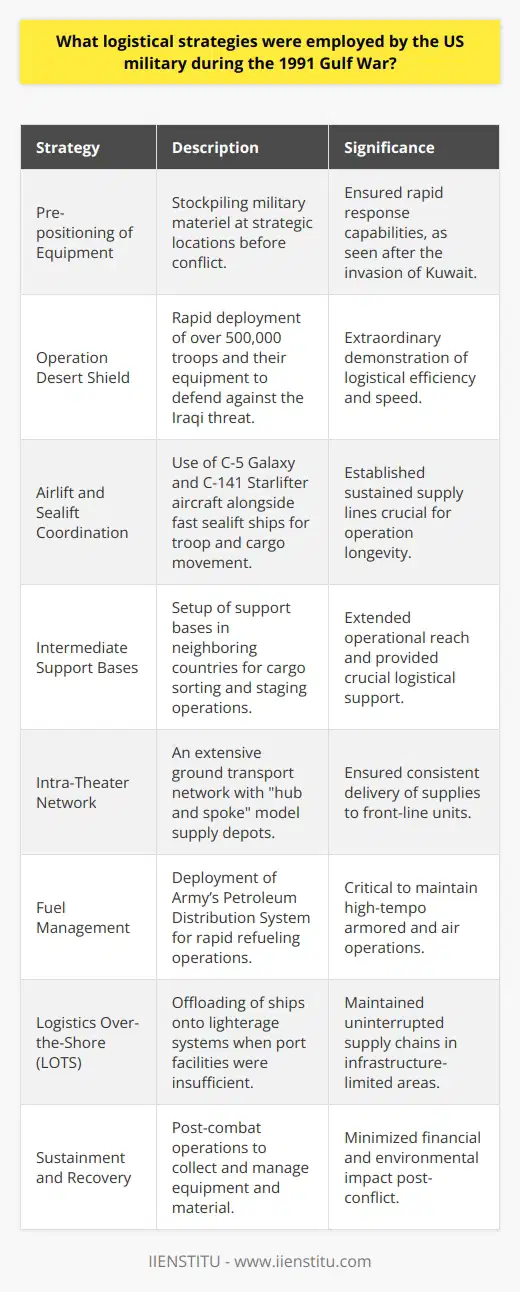
How did the US military ensure the efficient movement of troops and supplies during the 1991 Gulf War?
The 1991 Gulf War represented a significant test of the United States military's ability to efficiently move troops and supplies to a theatre of operations thousands of miles away. This task was complicated because the US had to coordinate with coalition forces from many nations and by the vast distances involved. This article will examine the techniques used by the US military to ensure the efficient movement of troops and supplies during the war.
The US military relied heavily on airlift to move personnel and equipment to the theatre of operations. A combination of military and commercial aircraft, including C-5 and C-141 cargo planes, C-130s, and even Boeing 747s, were used to transport the US and coalition forces. These aircraft could carry large amounts of personnel and supplies, allowing the military to deploy personnel and equipment quickly and efficiently.
In addition to airlift, the US military also relied on sealift to move large amounts of equipment and supplies to the theatre of operations. Several Navy transport ships, such as the USS Mount Whitney, were used to carry personnel and equipment to the region. These ships could carry large amounts of supplies and personnel and were essential for efficiently moving troops and supplies.
The US military also utilized advanced logistical planning and organization to move troops and supplies efficiently. The military established supply routes between military bases in the US and the Gulf region. It provided personnel with the necessary logistical support to ensure that supplies and personnel reached their destinations on time. Additionally, the military used sophisticated logistical software to track the movement of personnel and supplies and to monitor the progress of the operation.
Finally, the US military took advantage of the latest technological innovations to ensure the efficient movement of troops and supplies during the war. For example, the military used GPS-based navigation systems to provide real-time navigation data to the troops and supplies, allowing them to reach their destinations quickly and accurately. Additionally, the military used satellite communication systems to provide reliable and secure communications links between the US and coalition forces.
In summary, the US military ensured the efficient movement of troops and supplies during the 1991 Gulf War through airlift, sealift, advanced logistical planning and organization, and the latest technological innovations. These measures allowed the US military to quickly and efficiently deploy personnel and supplies to the theatre of operations and monitor the operation's progress.
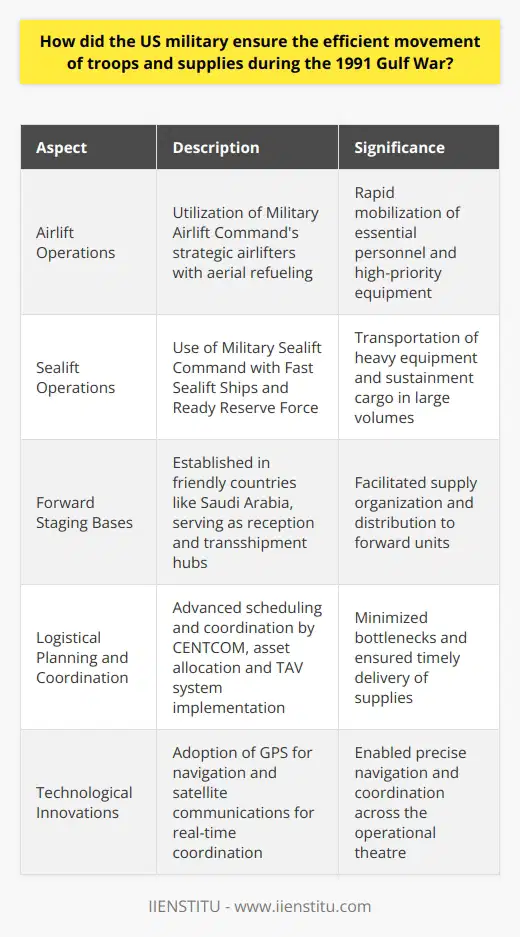
What resources were necessary for successful logistics management during the 1991 Gulf War?
In the 1991 Gulf War, successful logistics management was essential for the mission's success. Logistics management is a complex operation that requires significant resources and organization. This paper will discuss the resources necessary for successful logistics management during the 1991 Gulf War.
Personnel was the first resource necessary for successful logistics management during the 1991 Gulf War. Many personnel was needed for the planning, coordination, and execution of logistics operations. This included personnel from the military services, the Department of Defense, and other government agencies. Personnel had to be trained in logistics management and the operation of the various types of equipment used in the war. This included personnel from the Army, Navy, Air Force, and Marine Corps, as well as personnel from the United States Air Mobility Command and the United States Army Corps of Engineers.
The second resource necessary for successful logistics management during the 1991 Gulf War was materiel. This included various items, from food, fuel, ammunition, and medical supplies to vehicles, aircraft, and ships. The material had to be procured, transported, and stored to ensure its availability when needed. The material had to be transported to the front lines and forward base camps and supply depots.
Information was the third resource necessary for successful logistics management during the 1991 Gulf War. Information was essential for coordinating the logistics operations and for making informed decisions. This included information about the current situation, the enemy forces, and the terrain. Information was also needed about the availability and location of supplies, as well as the capabilities of the various types of equipment used in the war.
Communication was the fourth resource necessary for successful logistics management during the 1991 Gulf War. Communication was essential for coordinating logistics operations, as well as for providing timely information to personnel. This included radio, telephone, and satellite communications.
Finally, transportation was the fifth resource necessary for successful logistics management during the 1991 Gulf War. This included air, ground, and sea transportation. Transportation was necessary for the movement of personnel, material, and information.
In conclusion, successful logistics management during the 1991 Gulf War required significant resources, including personnel, material, information, communication, and transportation. These resources were essential for the successful execution of logistics operations and for ensuring the availability of the necessary supplies and equipment.

What was the strategy of the 1991 Gulf War?
Operation Desert Storm Strategy
The strategy of the 1991 Gulf War, codenamed Operation Desert Storm, was a combination of diplomacy, economic sanctions, and military force. The overarching objective was to expel Iraqi forces from Kuwait, which they had invaded in August 1990, and restore its sovereignty.
Diplomatic Efforts and Economic Sanctions
Initially, the United Nations (UN) employed diplomacy to demand Iraq's withdrawal from Kuwait through its Resolution 660. Following this, economic sanctions were imposed on Baghdad by adopting UN Resolution 661. Consequently, the UN imposed various measures, including trade embargoes and freezing of assets, intending to pressure Iraq into compliance without resorting to armed conflict.
Creation of Coalition Forces
Simultaneously, a multinational coalition was assembled, led by the United States and comprising 34 other countries. This partnership aimed at guaranteeing Kuwait's liberation, garnering international legitimacy, and demonstrating unified opposition to Iraq's aggression. Troops, airpower, and naval assets were deployed to the Gulf region, creating a powerful military presence to deter further aggression.
Air Campaign and Information Warfare
The next phase of the strategy involved an extensive air campaign to degrade Iraq's military capabilities and infrastructure. This operation aimed to demoralize enemy forces, disrupt their command and control systems, and create air superiority for the coalition. Furthermore, the utilization of information warfare through psychological operations and the manipulation of media narratives supported the strategic efforts in this regard.
Ground Offensive and Liberation of Kuwait
Following the success of the air campaign, coalition forces launched a swift ground offensive, codenamed Operation Desert Sabre. The primary goal was to outflank and encircle Iraqi troops, force their surrender or destruction, and minimize coalition casualties. Within 100 hours, the ground war resulted in the liberation of Kuwait and the withdrawal of Iraqi forces.
Consolidation and Stabilization
After achieving its main objectives, the coalition ceased offensive operations and engaged in efforts to consolidate its gains and stabilize the region. This entailed the implementation of post-war agreements, disarmament measures, and humanitarian assistance to mitigate the war's consequences.
In conclusion, the 1991 Gulf War strategy was a multi-pronged approach that combined diplomacy, economic pressure, and decisive military action to achieve its objectives. This approach showcased the importance of unified international efforts in addressing regional aggression and maintaining global security.
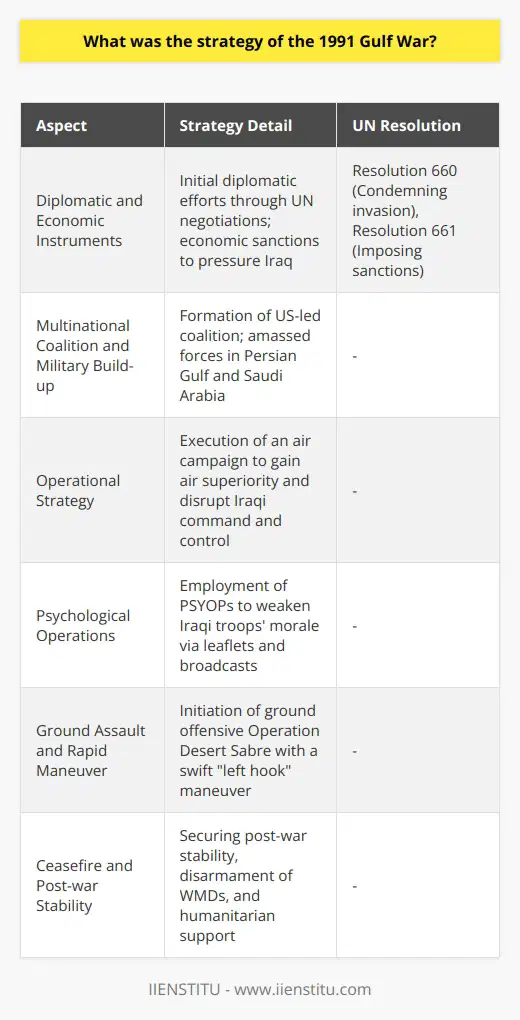
Was the 1991 Gulf War successful?
Assessing the Success of the 1991 Gulf War
Military Objectives Achieved
The 1991 Gulf War, also known as Operation Desert Storm, was a military success from the perspective of the United States and its coalition partners. The main objective, the expulsion of Iraqi forces from Kuwait, was achieved in a remarkably short period of time, with minimal coalition casualties. The war also succeeded in demonstrating the effectiveness of precision-guided munitions and modern military technology, as well as the value of international cooperation in addressing regional security threats.
Regional Stability Not Restored
Despite these accomplishments, the war did not achieve its broader strategic goals of restoring long-term stability in the region. Iraqi dictator Saddam Hussein remained in power, and his regime continued to cause regional instability through its repression of internal dissent and aggression toward its neighbors. While the war had succeeded in ending Iraq’s occupation of Kuwait, the victory had been secured at the cost of widespread destruction and loss of civilian life, particularly among the Iraqi population. This suffering contributed to the ongoing animosity between Iraq and its neighbors, particularly Iran, as well as fueled anti-American sentiment throughout the region.
Limited Impact on Weapons of Mass Destruction
Another objective of the Gulf War was to cripple Iraq's capacity to produce and deploy weapons of mass destruction. While the war did result in the dismantling of much of Iraq's nuclear, chemical, and biological weapons programs, it did not fully eliminate these capabilities. This would become a key justification for the 2003 invasion of Iraq by a U.S.-led coalition, which ultimately found that Iraq’s weapons of mass destruction capabilities had been largely overstated.
Humanitarian Consequences
The 1991 Gulf War also had significant humanitarian consequences. The conflict resulted in a large number of civilian casualties, particularly in Iraq, and led to a massive displacement of people throughout the region. Additionally, the imposition of economic sanctions on Iraq, which were meant to weaken Saddam Hussein's regime, instead caused widespread suffering among the Iraqi population. This led to criticism of the coalition's conduct of the war and questions about the ethics of imposing economic sanctions on a country already suffering from the effects of armed conflict.
Conclusion
In conclusion, while the 1991 Gulf War was successful in achieving its immediate military objective of liberating Kuwait, it fell short in achieving broader strategic goals related to regional stability and the elimination of weapons of mass destruction. Moreover, the war had significant humanitarian consequences for the Iraqi population, contributing to ongoing tensions in the region.
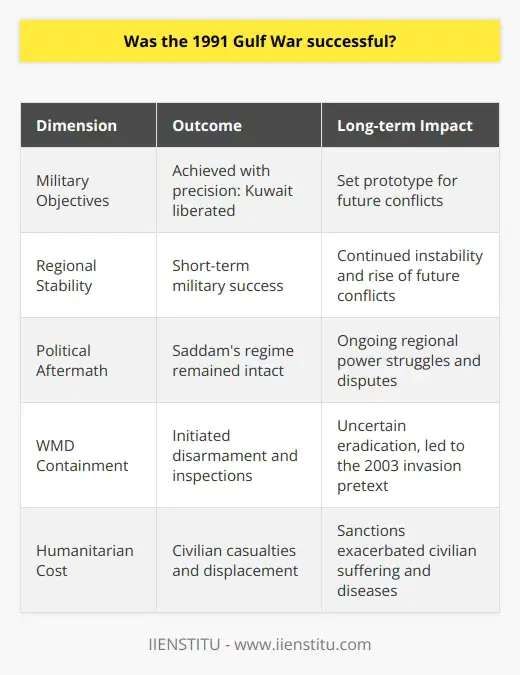
What was the significance of the 1991 Gulf War?
Significance of the 1991 Gulf War
Economic Impacts
The 1991 Gulf War, a military conflict between a coalition of 35 countries led by the United States against Iraq, had a significant impact on the world economy. First, it led to a considerable increase in oil prices, which disrupted the global market and affected energy-importing countries. Second, as a result of the war, the coalition nations accumulated large deficits that necessitated borrowing of funds, affecting their economic stability.
Political Consequences
The war also had far-reaching political implications. By subduing Iraq's military, the 1991 Gulf War attenuated Iraq's potential influence in the Middle East, creating a geopolitical vacuum that other regional powers, such as Iran and Turkey, sought to fill. Additionally, the war marked a tactical display of the United States' military prowess, solidifying its status as a global superpower in the post-Cold War era.
Humanitarian Crisis
The aftermath of the conflict left millions of residents in the region, particularly Kurds and Shi'is in Iraq, exposed to severe humanitarian crises due to the ongoing violence, persecution, and displacement instigated by Saddam Hussein's regime. Consequently, the international community had to intervene to deliver humanitarian aid, pitting the United Nations against the Iraqi government.
Environmental Effects
The environmental consequences of the 1991 Gulf War were substantial due to the Iraqi military's deliberate destruction of Kuwaiti oil wells and the subsequent uncontrolled release of crude oil throughout the region. Following the war, extensive efforts were undertaken to mitigate the adverse ecological effects of the war, including the extinguishing of well fires, the cleanup of oil spills, and the reclaiming of tainted land.
Influence on International Relations
Moreover, the war shaped international relations. First, it heralded a new era of cooperation between countries that were previously at odds during the Cold War, exemplified by the broad-based coalition formed to oppose Iraq. Second, the conflict exposed the limitations of the United Nations, primarily in its ineffectiveness in preventing Iraq's invasion of Kuwait and the subsequent suffering of innocent civilians.
In conclusion, the 1991 Gulf War had significant economic, political, humanitarian, environmental, and international relations implications that shaped the world in the ensuing years. By affecting the world economy, altering the political landscape, and catalyzing an international humanitarian crisis, the war continues to serve as a focal point of analysis and discussion for scholars and policy experts alike.

Which strategy contributed to US success in the 1991 Gulf War?
Strategy Underpinning US Success
Operation Desert Storm, the main combat phase of the 1991 Gulf War, witnessed the effective application of overwhelming force by the US.
Superior Military Technology
A key strategy that contributed to US success was the use of superior military technology. Advanced weapons systems, such as smart bombs and stealth aircraft, gave American forces a significant edge.
Air Superiority
In addition, the US achieved air superiority very early in the conflict. The ability to control the air and attack from above greatly facilitated ground operations.
Swift Mobilization
The US also benefited from swift and extensive mobilization. Rapid deployment of forces ensured a timely and efficient response.
Coalition Building
Moreover, the US led a large coalition of countries against Iraq. This not only distributed military burden but also added diplomatic and political legitimacy to the cause.
Psychological Warfare
Psychological warfare was another crucial part of the US strategy. The aim was to demoralize the enemy and lower their resolve to fight.
Lastly, by focusing on the objective of liberating Kuwait, rather than occupying Iraq, the US avoided a possible quagmire. An extended occupation might have led to a protracted and costly conflict. By avoiding this, the US achieved its objectives with relatively low casualties and costs.
In conclusion, a combination of superior technology, air superiority, rapid mobilization, coalition building, psychological warfare, and a clear focus on objectives contributed to the success of the US in the 1991 Gulf War.
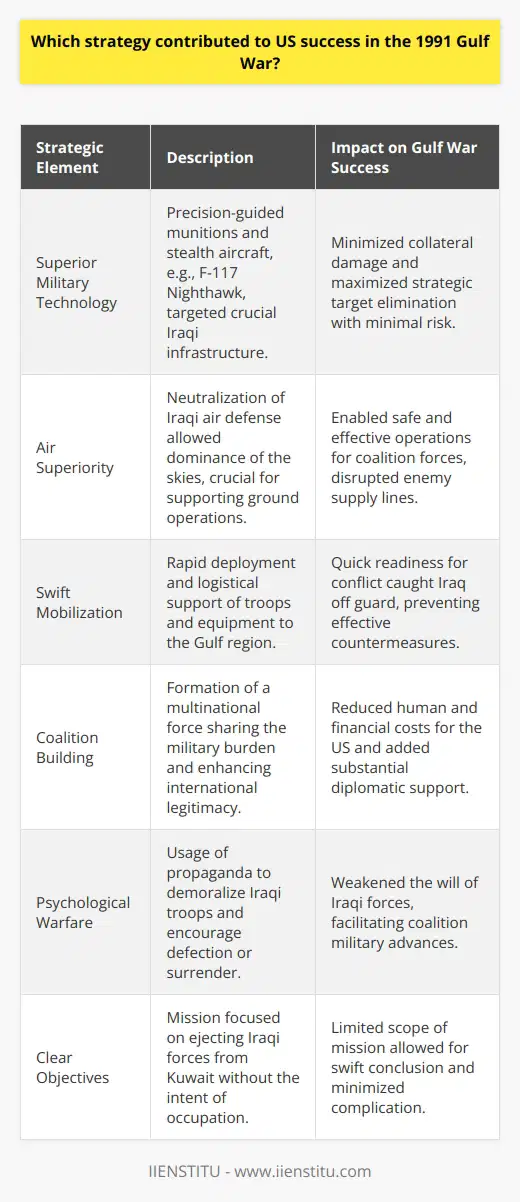
How did the coalition forces coordinate their efforts to achieve their objectives during the 1991 Gulf War?
Coordination Strategy:
The coalition forces in the 1991 Gulf War coordinated their efforts in a strategic manner. Close cooperation between international forces was paramount to operational success.
Alliance Management:
Key military organizations from 35 nations under a collaborative structure formed the backbone of this coalition. The United States, being the most potent military power, led the coalition efforts. The U.S. Department of Defense provided overarching guidance and leadership.
Information Sharing:
Efficient exchange of intelligence and operational data was an essential coordination tactic adopted. This involved sharing real-time battle-space awareness among all coalition entities.
Operational Planning:
Joint operational planning facilitated global coordination on a large scale. Nations combined their operational capabilities to mount an intercontinental offensive. Each country identified their expertise, and roles were assigned accordingly.
Logistics Coordination:
Logistics coordination was a critical factor for the coalition’s success. Nations channeled their resources to maintain a steady supply of men and materials during the war. Effective logistics management resulted in efficiency and reduced operational redundancy.
Communication Capabilities:
Strong communication lines helped in fostering shared understanding among the international forces. Reliable and secure communication technology ensured seamless cross-coalition interaction.
In conclusion, effective coordination within the coalition forces was the result of collaboration, communication, operational planning, logistics optimization, and information sharing. These strategies collectively played a significant role in achieving the objectives of the 1991 Gulf War.
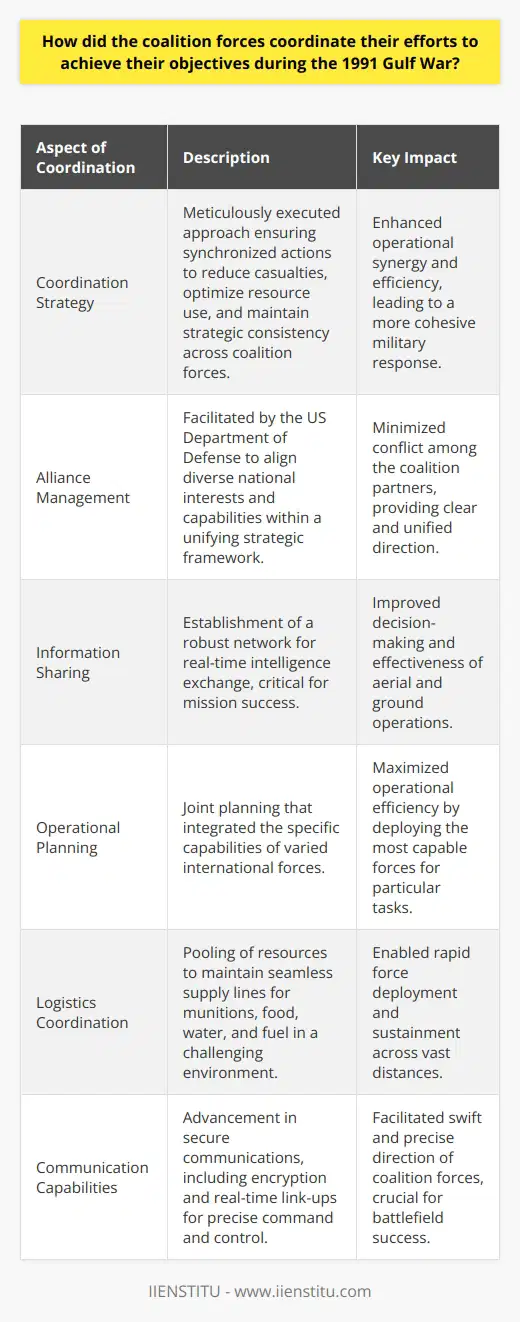
What technological advancements played a crucial role in the US military's effectiveness in the 1991 Gulf War?
Precision-Guided Munitions
The use of Precision-Guided Munitions (PGMs) greatly enhanced the U.S. military's efficiency during the 1991 Gulf War. These weapons include laser-guided bombs, cruise missiles, and tactical ballistic missiles.
PGMs, often referred to as 'smart bombs,' significantly increased the damage to enemy targets. These weapons had in-built systems that guided them to specific targets with high precision. This technology not only reduced the number of munitions required but also minimized collateral damage.
Stealth Technology
Another crucial advancement was the use of stealth technology. The U.S. Air Force's F-117 Nighthawk, a stealth attack aircraft, played a substantial role in the war. This aircraft could evade enemy radar detection, enabling precise bombing operations in enemy territory without substantial risk of interception.
Satellite and Radar Systems
In addition, Satellite and Radar systems provided critical intelligence and targeting information. The military used satellites for surveillance, reconnaissance, and communication purposes. Radar systems facilitated the detection of enemy movements and locations.
Digitized Battlefield
Finally, the Gulf War marked the first large-scale implementation of a digitized battlefield. Digital systems integrated different elements of warfare, including intelligence, operations, and logistics into one network. This allowed for real-time transmission of information and improved decision-making processes on the battlefield.
In conclusion, a combination of precision-guided munitions, stealth technology, satellites and radar systems, and digitization revolutionized the U.S. military's effectiveness in the 1991 Gulf War. These technological advancements not only led to operational success but also fundamentally changed the nature of warfare.
